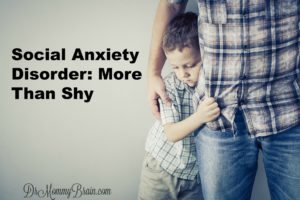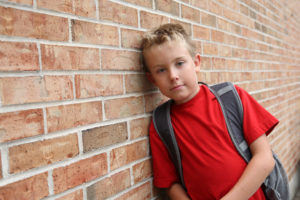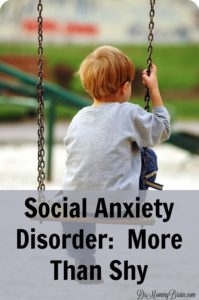Being shy is a far cry from social anxiety disorder.
Unfortunately, this is not something that we hear acknowledged in society.
We are fond of our boot strap approach to solving other people’s problems and overcoming other people’s challenges. This is a significant barrier in mental health treatment in the United States in how it is provided, how it is covered, and when it is sought.
As with so many things society as a whole would benefit from a bit more empathy and a greater comprehension of the struggles others are facing.
Social anxiety is often brushed aside as being “just shy.” This over time can allow the struggle to take deeper root and evolve into greater isolation and debilitation.
Seeking professional help can make all the difference in how fulfilling and engaging a life someone with social anxiety is able to live.

sad son hugging his dad
Shy Vs. Social Anxiety
Shy:
Being shy is a personality trait. It is part of who a person is. Being shy makes it difficult to speak up. It may make a person tend to shy away from attention and crowd interactions. Being shy may make someone feel uncomfortable meeting new people, but it does not make it impossible. A person who is shy may have a tendency to be ordered around and bent to the will of others.
Social Anxiety:
Social anxiety is an anxiety disorder characterized by severe debilitating reactions to basic social interactions that often present as panic attacks.
As a psychologist, I have had parents ask me questions over the years about whether or not they should be concerned about their child. Frequently I have been asked about a child’s “shyness” and if there was cause for concern.
Of course, to answer I would need more information.
Questions to Consider: If you think your child may have Social Anxiety Disorder
1. Is the child worried about it or appear to be distressed?
2. Does the child participate in social interactions regularly such as recess socializing, sports, or play dates?
3. Does the child avoid large gatherings like birthday parties? Does it upset them to miss these things if they do?
4. Does the child seek to avoid attending school or specific portions of the school day?
5. Does the child express feelings of shame, disappointment, or inadequacy about their social performance?
6. Has the child reported or been observed to experience shortness of breath or sudden onset of severe distress during or in anticipation of a social experience?
After discussing these questions we usually reach a decision that the child is just shy. They may prefer to avoid public speaking and be easily embarrassed when the attention of a group is focused on them. We are just not all built to play the lead in the school play. Not everyone wants to be the prom queen, and not everyone enjoys having the whole restaurant stare at them while singing happy birthday. That is ok. In fact, it is just another piece of the rainbow that makes this beautiful world full of unique and interesting people.

Boy with backpack at school
Shy people can live rich and fulfilling lives. They tend to have deep meaningful relationships with people. They may be fewer but the quality is rich and they are often very empathic tender people.
People who suffer from social anxiety, on the other hand, can face enormous challenges in life. The social anxiety that they experience can become self-reinforcing and exacerbating until they become agoraphobic.
This is because in cases of social anxiety the symptoms become a cycle. A cycle in which the anxiety is associated with the social interaction. The person experiences strong anxiety symptoms sweating, racing heart, fear, maybe a full panic attack in a social situation. As it develops they begin to feel the same symptoms as they approach a similar situation. As time goes on they start to experience symptoms of panic at even the thought of going into that social situation. As this occurs they avoid social situations to alleviate the anxiety. That helps at the moment but reinforces that to them that they cannot handle the situation. In time the panic is triggered by other social situations so the anxiety is broadened to a wider range of their life.
Example: Robert is asked to present in front of the class. He is very nervous about the presentation and has a panic attack, during which he feels like he cannot breath and like he is having a heart attack. Robert after that avoids classes that require presentations and takes an F for the portions of classes that require presentations because even the thought of giving a presentation makes him feel out of breath.
When a person with social anxiety experiences these symptoms they often describe feeling inadequate and ashamed. They are afraid of the impact that this anxiety is having on their life and their loved ones. They experience a great deal of self-doubt and depression.
While people who are shy may prefer to not be in certain situations they know that they can survive the situation even if they do not prefer it. A person with social anxiety believes that they cannot handle a situation and is not alright with it.

lonely boy in the park
Social Anxiety and Treatment
Social Anxiety warrants treatment. Over time efforts are made to avoid situations in which the person has in the past experienced anxiety symptoms. Social anxiety symptoms continue to occur in new situations. Over time these new situations come to be avoided as well increasingly limiting the person’s world and their experience of life. Eventually, this can lead to agoraphobia.
Treating social anxiety is similar to treating many other anxiety disorders and phobias. It is a good idea to work with a licensed experienced psychologist. It is preferable to work with a psychologist who has treated social anxiety in the past, and identifies as having a cognitive behavioral approach to treatment. Research has indicated that cognitive-behavioral techniques are most effective in the treatment of this disorder.
During treatment, several things will happen.
1. Social Skills: The current social skills will be evaluated. After that additional social skills will be taught and the child will be asked to evaluate their social skill presentation.
2. Address distortions: You may wonder why the patient would evaluate their own social skills. Often in social anxiety the patient presents with unrealistic distortions of how they are perceived by others or their presentation. Other times there are catastrophic distortions about how situations could go wrong. Patients are taught ways to stop themselves when they are having unrealistic troublesome thoughts about their social performance. They are then taught to replace negative thoughts with more positive thoughts that are reinforcing to social engagement.
3. Facing Down The Fear: After building up some social skills and working on the patients perception of those skills it is time to face the fear. This is generally done by creating a list of feared situations and ordering them in intensity levels. The patient is then challenged to move through the list enduring incrementally the fears that are provoked by exposure. So the patient does not hop right into a school dance but perhaps attends a reading time at the library where they stand at the back and over a few weeks move to sitting as part of the group for the duration of the session. Over time challenge by challenge they work their way up to attending a birthday party or asking a question in class.
Group Therapy: It may initially seem almost comical to think about treating social anxiety in a social group. There is something profoundly powerful about the dynamic. The participants all know that the others are also uncomfortable and it becomes easier to believe that they themselves are not being judged harshly. Through their eyes, they are able to see the others as being fine and making gains. When this is reflected back to them by the other participants the strength of the impact is much greater than you may imagine.
Treatment of social anxiety is a long term process. Changes to the behavior and reasoning must be slow and incremental to avoid being too overwhelming. If the patient becomes overwhelmed the result is often a negative setback and additional resistance to participating in treatment.
You will notice that during the discussion of treatment I switched to referring to the patient rather than the child. While this site focuses a good deal on children treatment of social anxiety is, for the most part, the same for adults, teens, and young children.

Father giving daughter encouragement
How Parents Can Help!
It is difficult for anyone to watch someone they love struggle with any disorder. As parents, this becomes even truer. We feel our child’s suffering as if it is our own. We criticize ourselves for how the problem came to be and blame ourselves for inflicting things that are often beyond our control. May these suggestions help you feel empowered and push away any feelings of helplessness you may be feeling.
- Understand that Social Anxiety is not something that was inflicted by parenting style.
- Understand that you cannot correct Social Anxiety in your child through discipline. They are not ale to just stop if you order them to overcome the fear.
- If you as a parent are seeing something in your child’s behavior that you think is social anxiety I urge you to consult a licensed child psychologist. Young children are exceptionally treatable because their thinking and reasoning are more flexible. Just another reminder of the resiliency of childhood! As a parent, if you seek professional help then you have already taken an enormous first step in helping your child.
- Children also have the benefit of having built in constant therapy coaches in their parents. You will work with your child’s therapist to learn how you can best support and encourage your child while challenging them to achieve growth and improvement.
Don’t let social anxiety stand in the way of a full and happy life. It is not something to be lived around but rather overcome.

Shannon
Latest posts by Shannon (see all)
- Social Anxiety: More Than Shy - July 10, 2016
- 3 BIG Reasons To Give Children Specific Meaningful Praise - June 27, 2016
- Protecting Children From Sexual Predators: Safety Without Paranoia - June 6, 2016


Leave a Reply